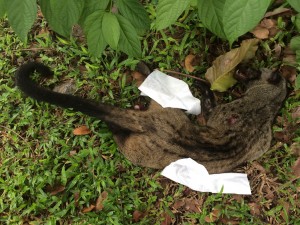Two days before Christmas 2014, I came into office expecting an uneventful day. Not long after I reached campus, I received a notification from Nurliyana Omar, an Otterman Holt graduate who previously conducted a research on the fishtail palm (Caryota mitis). Liyana reported a common palm civet roadkill carcass along Clementi Road, at the NUS Arts Faculty entrance on the first left lane.
This was the third civet roadkill reported to us in the month of December.
Once a roadkill is reported, it is always a race against time and traffic to recover an intact carcass. We could not retrieve the first civet roadkill at Goodwood Hill, reported to us by Dr Darren Yeo, as by the time Tze Kwan arrived at the scene, the civet had already been crushed by multiple vehicles. Instead, tissue and hair samples were collected and deposited in the cryo collection in the Lee Kong Chian Natural History Museum.
Therefore when I received the notification from Liyana, I quickly gathered the necessary equipment for carcass recovery and headed over to the Arts Faculty via the ridge. Even before I had a visual of the body, I could smell a whiff of pandan-like musk at the traffic junction. I looked across and saw a long slender black tail at the edge of the road metal railing. My heart sank. It was a common palm civet.
I took photos of the carcass and realized that the civet had sustained many injuries due to the impact from the vehicle. The body was distorted and there was blood on its face and hind leg. After taking the photos, I put on gloves and gingerly placed the civet into a bag to carry back to Science Faculty. As I carried it back to the ridge, I could not help but feel the weight of this usually elusive nocturnal animal. It was alive and well just a couple of hours ago.
Many times I would think of how we can help these last wild urban carnivores and many other wildlife that live in coexistence with human in Singapore’s urban landscape. It could be a small action such as driving a little slower, slowing down our pace of life to appreciate nature or even sharing these wonders with our friends and family. This can make all the difference between life and death for an animal. Every person can be the catalyst for change. As 2014 draws to a close, I hope that each of us can do our part and make a difference for wildlife in Singapore.

